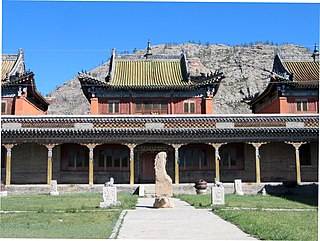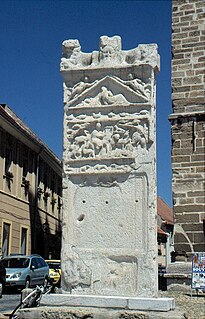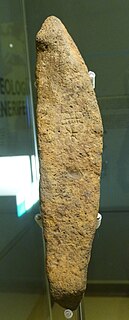 W
WA stele, or occasionally stela, when derived from Latin, is a stone or wooden slab, generally taller than it is wide, erected in the ancient world as a monument. The surface of the stele often has text, ornamentation, or both. These may be inscribed, carved in relief, or painted.
 W
WThe Bagnolo steles are two stone boulders found in Ceresolo-Bagnolo, Malegno commune, Brescia province, Lombardia, Northern Italy, at the base of Monte Mignone, at an altitude of ca. 700 m. Bagnolo 1 was discovered in 1963, bearing depictions of 14 items, engraved by hammering. Recognizable are drawings of a Sun, an axe and several daggers of the "Remedello" type, a belt and an ibex.
 W
WThis marble fragment of a funerary stele depicting a boxer is dated at circa 540 BC. The individual's depiction as a boxer is apparent in his broken nose, cauliflower ear, and the strapped wrist that he holds aloft – these straps were used by the Ancient Greeks to secure knuckle-guards for boxing competitions. It is considered one of the earliest examples of a highly individualized athlete depiction in Ancient Greek sculpture, and "nearer to a portrait than any other work surviving from Archaic Greece". It utilizes relief carving techniques to characterize a subject long before high degrees of individual characterization were apparent in freestanding sculpture.
 W
WThe Bugut inscription is a multi-lingual inscription first discovered in Ikh-Tamir sum of Arkhangai Province, Mongolia. The inscription is dated to 584 CE and was dedicated to Taspar Khagan the fourth Khagan of the Turkic Khaganate. The inscription is in the form of a monumental wolf-crowned stele 198 cm high that sits on a turtle base 47 cm high. The front, right and left side of the stele has a Sogdian inscription written with Sogdian alphabet. The back side has a possibly Ruanruan inscription written with Brahmi script. The original location of the inscription on the west bank of the Bayantsagaan river, a tributary of the North Tamir river, shows evidence of a walled complex. The wall embankment is 59mx30m with an inner moat 4.5m wide and 2m deep. In the center of the walled complex was a temple whose wooden pillars and roof tiles were still visible on the ground. Only a few brick fragments were found. The inscription itself was found within the walls on a square platform 7.5mx7.5m made of layered stones.
 W
WThe Cantabrian stelae are monolithic stone disks of different sizes, whose early precedents were carved in the last centuries before the romanization of Cantabria in northern Iberian Peninsula. Cantabrian stelae include swastikas, triskeles, crosses, spirals, helixes, warriors or pre-Roman funerary representations among their usual ornamentation. The most famous is called Estela de Barros which can be visited in the Parque de las Estelas in the town of Barros, in Los Corrales de Buelna. This stele is part of the current coat of arms of Cantabria and the meaning of tetraskelion would be related to solar worship. The Barros stele giant size represents the main difference to the smaller stelae found in other parts of northern Spain. In addition to the Estela de Barros, we can see another larger, fragmented stele in the Parque de las Estelas.
 W
WThe Cippus Perusinus is a stone tablet discovered on the hill of San Marco, near Perugia, Italy, in 1822. The tablet bears 46 lines of incised Etruscan text. The cippus is assumed to be a text dedicating a legal contract between the Etruscan families of Velthina and Afuna, regarding the sharing or use of a property upon which there was a tomb belonging to the noble Velthinas.
 W
WA Daunian stele is a type of stone funerary monument constructed by the Daunians, an Iapygian tribe which inhabited Apulia in classical antiquity. Daunian stelae were made from the end of the 8th century BC to the 6th century BC. They consist of a parallelepiped-shaped plate, which protrudes from the upper head and decorated on all four sides. Sizes vary between 40 and 130 cm in height, and consequently, between 20 and 80 cm in width while the thickness is between 3 and 12 cm.
 W
WIn the ancient Greek city of Demetrias in Thessaly, funerary stelai showed an assortment of mythological scenes, battle scenes, and more, all using the art styles of the Hellenistic period. Stelai in Ancient Greece were used almost in the same manner as modern tombstones, commemorating the dead. They were made of stone or marble, mainly. They often either showed scenes from the deceased's life, or a mythological scene. The use of stelai in Ancient Greece have been observed dating back to the bronze age.
 W
WThe International Stele Always Remember is an outdoor HIV/AIDS memorial in Berlin, Germany.
 W
WThe Kerameikos steles are a collection of sculptures used as grave-markers in the Kerameikos necropolis of Attica. Kerameikos is located outside the Themistoclean Wall's Dipylon Gate. Stelai come in various shapes/designs and depict images varying from pottery to narrative scenes. They were often marble or limestone, and were carved or sculpted to depict the person being memorialized sometimes with relatives or slaves. Reliefs decorating the graves were meant to show the dead in their best light, using imagery to recognize their bravery in battle, or pathos, or wealth. These monuments marked the graves of Athenian men, fallen warriors, as well as non-citizens. Women were also included in Kerameikos but typically it was the wealthiest or prominent women who were given stele. In many vase paintings of grave scenes wreaths are seen resting at the base of stele. This was likely a popular way to adorn the graves of Greek loved ones.
 W
WKurgan stelae or Balbals are anthropomorphic stone stelae, images cut from stone, installed atop, within or around kurgans, in kurgan cemeteries, or in a double line extending from a kurgan. The stelae are also described as "obelisks" or "statue menhirs".
 W
WThe Lazare Costa inscriptions are a group of Punic inscriptions found in Constantine, Algeria between 1875 and 1880 by Lazare Costa, a Constantine-based Italian antiquarian. Most of the steles are now in the Louvre.
 W
WThe lunette spatial region in the upper portion of stelas, became common for stelas as a prelude to a stele's topic. Its major use was from ancient Egypt in all the various categories of stelas: funerary, Victory stelas, autobiographical, temple, votive, etc.
 W
WThe stele of Prusias is one of the ex votos at the sanctuary of Apollo in Delphi, constructed in honour of king Prusias II of Bithynia.
 W
WThe Orpheus Monument is a Roman monument in Ptuj, Slovenia, an almost 5 metres (16 ft) high and about 1.8 metres wide stele, carved of white Pohorje marble. It is located at Slovene Square, the town's central square, in front of the Town Tower. It is the oldest public monument preserved in its original location in Slovenia, the largest discovered monument from the Roman province of the Pannonia Superior, and the symbol of Ptuj.
 W
WA Pictish stone is a type of monumental stele, generally carved or incised with symbols or designs. A few have ogham inscriptions. Located in Scotland, mostly north of the Clyde-Forth line and on the Eastern side of the country, these stones are the most visible remaining evidence of the Picts and are thought to date from the 6th to 9th century, a period during which the Picts became Christianized. The earlier stones have no parallels from the rest of the British Isles, but the later forms are variations within a wider Insular tradition of monumental stones such as high crosses. About 350 objects classified as Pictish stones have survived, the earlier examples of which holding by far the greatest number of surviving examples of the mysterious Pictish symbols, which have long intrigued scholars.
 W
WThe Raimondi Stele is a sacred object and significant piece of art of the Chavín culture of the central Andes in present-day Peru. The Chavín were named after Chavín de Huantar, the main structure found in ruin at this archaeological site. The Chavín are believed to have occupied this space from 900 BCE to 200 BCE, which places them in the Early Horizon period of Andean cultures. The Early Horizon came to rise after the spread and domination of Chavín art styles, namely the hanging pendant eye and anthropomorphism/zoomorphism of feline, serpent, and crocodilian creatures. The stele is seven feet high, made of highly polished granite, with a lightly incised design featuring these key artistic choices shown in the depiction of the Staff God. After not being found in situ, the stele now is housed in the courtyard of the Museo Nacional de Arqueología Antropología e Historia del Perú in Lima.
 W
WThe Ram Khamhaeng Inscription, formally known as Sukhothai Inscription No. 1, is a stone stele bearing inscriptions which have traditionally been regarded as the earliest example of the Thai script. Discovered in 1833 by King Mongkut, it was eventually deciphered and dated to 1292. The text gives, among other things, a description of the Sukhothai Kingdom during the time of King Ram Khamhaeng, to whom it is usually attributed. The inscription had immense influence over the development of Thai historiography from the early 20th century, which came to regard Sukhothai as the first Thai kingdom.
 W
WThe Stele of Davati is a cross-shaped limestone stele, carrying a bas-relief, depicting Virgin Mary alongside the archangels Michael and Gabriel, with one of the earliest inscriptions in Georgian Asomtavruli script. The upper part of the stele that is assumed to have been depiction of the Feast of the Ascension is broken and lost. It has been dated from the 4th to the 5th century. The stele was discovered in 1985 in a small Church of the Virgin in highland village of Davati, Dusheti Municipality.
 W
WThe Stele of Vespasian is a stele with Ancient Greek inscriptions found in 1867 at Armazi, near Mtskheta, Georgia in the ancient capital of the Kingdom of Iberia. The stele memorialises reinforcement of fortification of Armazi walls by Emperor Vespasian. Additionally, the inscription mentions two emperors Titus, Domitian and two kings Mihrdat I of Iberia, Pharasmanes I of Iberia and prince royal Amazaspus. The inscription is dated 75 AD. The top of the stele is lost. According to Professor David Braund the missing text was in Latin or Armazic. Cyril Toumanoff identifies Amazaspus as King Amazasp I of Iberia, though it can be prince royal Amazaspus, son of Pharasmanes I of Iberia, who is known from the Epigram of Amazaspos found in Rome.
 W
WTerengganu Inscription Stone is a granite stele carrying Classical Malay inscription in Jawi script that was found in Terengganu, Malaysia. The inscription, dated possibly to 702 AH, constituted the earliest evidence of Jawi writing in the Malay world of Southeast Asia, and was one of the oldest testimonies to the advent of Islam as a state religion in the region. It contains the proclamation issued by a ruler of Terengganu known as Seri Paduka Tuan, urging his subjects to extend and uphold Islam and providing 10 basic Sharia laws for their guidance.
 W
WThe Zanata Stone, also known as the Zenata Stone, is a small stele with engravings. The tablet is presumably of Guanche origin. It was found in 1992 near a mountain known as Montaña de las Flores in the municipality of El Tanque, located in the northwestern part of Tenerife, Canary Islands.